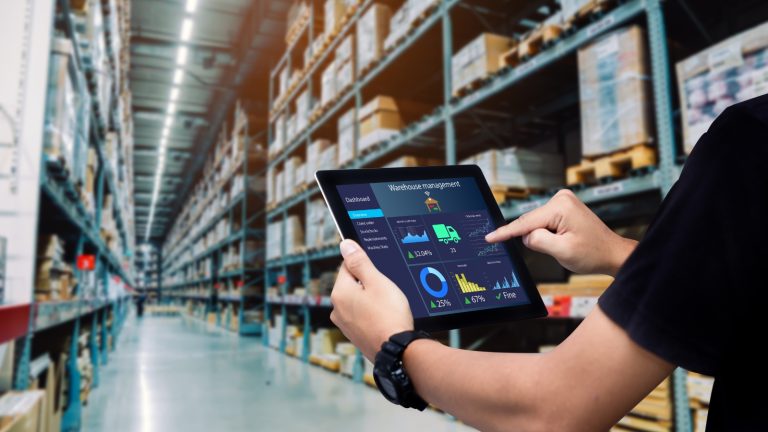If you look into every successful supply chain, you will find that one secret pours the base of its success, which is efficient warehouse operations. In recent times, we witnessed that customer expectations rose upwards uncontrollably and logistics networks transformed to be more complex. This is where many manufacturing companies focused on a new strategy; opting for Warehouse Management Systems (WMS)! It sort of acts as a digital engine to bring accuracy, control, and speed onto the same ground.
But do not think that all the WMS solutions in today’s market are equal. There are many factors that make each of the WMS distinct. It can be their capabilities, deployment models, and industry focus. If you wish to select the right type, you need to do it based on your business needs, warehouse size, integration goals, and most importantly, the budget.
In this article, we help you understand the six major types of Warehouse Management Systems, revealing each with distinct advantages and features.
What is a Warehouse Management System?

- A Warehouse Management System is a specifically developed software platform that is enriched with the potential to manage and optimise every phase that comes under all warehouse operations. This ranges from order fulfilment, receiving, put-away, to shipping.
- It is designed to give real-time visibility into inventory levels, while revealing places for storage, and look into the worker efficiency in the manufacturing business. This allows businesses to increase productivity, decrease mistakes, and improve consumer satisfaction under one singular screen.
- It is true that a warehouse management system comes with the digital strength to promote seamless coordination across the supply chain, as it is capable of automating manual procedures and connecting with other systems, such as Enterprise Resource Planning (ERP) or Transport Management Systems.
- In broad terms, a WMS simply remains at the central position in manufacturing warehouse operations, aiding in boosting accuracy, cost-effectiveness and efficiency.
6 Main Types of Warehouse Management Systems

Standalone WMS (On-Premise Focused)
A standalone WMS exists only to handle warehouse operations, including labour management, inventory control, and order processing. It usually goes live on-premise and operates independently, but if needed, it has enough capacity to be merged with ERP or Transport Management Systems (TMS).
For example, if we consider a mid-sized distribution facility, they can easily manage receiving, put-away, and picking with a single WMS. It is certainly not essential to have a comprehensive ERP system, but rather seeks to increase accuracy and decrease manual mistakes.
Benefits:
- Inventory and order management functionality is primarily focused.
- Staff training will be faster and easier to complete.
- Reduce initial software complexity.
However, this comes with some drawbacks as well. Standalone solutions could be missing deep integration, and they may lack the potential to offer corporate insight. There may be challenges with limiting scalability when your organisation grows.
Cloud-Based WMS (SaaS Model)
Cloud-based WMS is hosted on remote servers, and the users have to access it through the internet. What happens in here is, instead of purchasing and maintaining local hardware, enterprises only need to pay a subscription cost, which is often based on users, transactions or storage.
In its practical applications, we can witness that many e-commerce retailers with various fulfilment centres tend to implement a cloud WMS. This type of business can receive the optimal benefits as the latter makes it easier to manage inventory across locations and handle seasonal fluctuations.
Benefits:
- Quickly deployable and available from anywhere.
- Scales effortlessly as the business grows.
- Lowers IT maintenance and infrastructure expenses.
- Provides real-time visibility across several sites.
The problem is that internet access is critical for performance. Plus, most importantly, enterprises that handle sensitive data must consider vendor security and compliance requirements.
Integrated WMS (Part of ERP or Enterprise Suite)
An integrated WMS signifies a built-in software component within larger Enterprise Resource Planning (ERP) or Supply Chain Management (SCM) systems. The uniqueness of this is that, rather than being a separate product, the WMS relies on the same database and procedures as procurement, financials, and production.
In the real world, a worldwide manufacturer may decide to go with an ERP suite that comprises warehousing, procurement, and inventory modules all under one platform. This allows the organisation to keep tracking the goods from the supplier to dispatch in a single platform.
Benefits:
- Data unification and full process visibility.
- Reduces duplication and complex data input.
- Strong analytics and cross-functional reporting.
It is challenging that integrated WMS modules can turn out more costly and less universal than specifically dedicated systems. On the other hand, its implementation also takes longer due to the ERP’s extensive reach.
Supply Chain Management (SCM) Module WMS
Some advanced WMS packages go beyond warehousing borders to combine supply-chain aspects like demand forecasting, transportation management, and analytics dashboards. These are especially beneficial to businesses that wish to obtain complete insight into the flow of goods and the effectiveness of their logistics mechanisms.
For instance, let’s take a third-party logistics (3PL) provider. That company can combine its WMS with TMS and analytics technologies to make forecasting demand, inbound, outbound shipping, and overseeing carrier contracts in real time quite smooth.
Benefits:
- Data has been centralised across procurement, inventory, and transportation.
- Predictive analytics facilitates better decision-making.
- Reduces stock-outs while improving service levels.
It has to be a consideration that such systems are sophisticated. In order to establish, implement and maintain, the company will require professional IT help or experts.
Industry-Specific WMS
Certain industries have to adhere to very specialised compliance and operating requirements. This is where the industry-specific WMS systems come to the spotlight as they are designed to suit these special requirements. Since they offer outstanding features like pre-configured features, procedures, and data models, they become a great support for the manufacturers when adhering to industry standards.
In the real world, it has a great level of demand from pharmaceutical distributors. They employ healthcare-specific WMS featuring temperature-controlled storage monitoring, batch and lot surveillance, and legal compliance capabilities like FDA 21 CFR Part 11.
Benefits:
- Meets tight regulatory and quality specifications.
- Offers customised reporting and procedures.
- Reduces customising time by adhering to industry best practices.
If a manufacturer is on a tight budget, this might not be the ideal choice. These types of WMS are more expensive and less applicable to sectors other than those targeted.
WMS Lite for Micro-Fulfilment Centres (MFCs)
Today, the same-day delivery has become more common, and numerous businesses are turning to micro-fulfilment centres (MFCs). This means the small urban warehouses were built for speed and closeness. These demand small, rapid, and intelligent solutions, sometimes referred to as WMS Lite.
This is an ideal alternative for a supermarket chain. It can develop a micro-fulfilment WMS that is connected with AutoStore automation. The software integrates features like order processing, inventory control, job management and connects with autonomous robots and scanners.
Benefits:
- Highly space-saving, making it perfect for compact urban warehouses.
- Integrates effortlessly with automation and ERP systems.
- Provides real-time order fulfilment and inventory visibility.
The drawbacks come from the fact that these lightweight solutions could struggle to deal with complicated enterprise-wide activities. However, they are outstanding at boosting last-mile delivery efficiency.
Industry 4.0 Powered WMS for All Manufacturing Procedures

Cerexio Industry 4.0-powered WMS combines all the powerful technologies, such as AI, IoT, real-time analytics and robots to bring together all manufacturing processes, from raw material monitoring to production scheduling and completed goods distribution. Cerexio WMS is the best possible strategy to increase automation, visibility, and decision-making, which leads to seamless coordination, increased productivity, decreased downtime, and smarter, data-driven manufacturing processes throughout the entire facility.
Choosing the Right Type of WMS for Optimal Manufacturing Outcome

The expected outcomes flow easily to your business if you opt for the right WMS type, carefully considering your process requirements, complexities and business expectations in the first place. If you expect optimal manufacturing outcomes tomorrow, then hold hands with the right type of WMS with robust features that align with your business.
FAQ about Warehouse Management System
The main functions that happen within a warehouse are receiving, storage, picking, and shipping. Each of these functions comprises an assortment of operations that are critical to the effective operation of any warehouse.
A warehouse management system (WMS) yields operational advantages across diverse organisational contexts that store, deliver, or maintain goods, including manufacturers, retailers, e-commerce, and 3PL providers.
It automates manual operations, augments storage efficiency, decreases picking mistakes, and facilitates dynamic data exchange that allows for greater decision-making and accelerates order fulfilment through process automation and optimisation.
